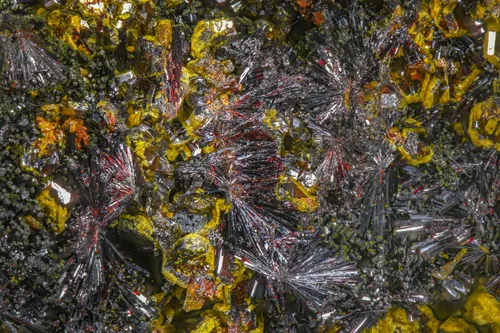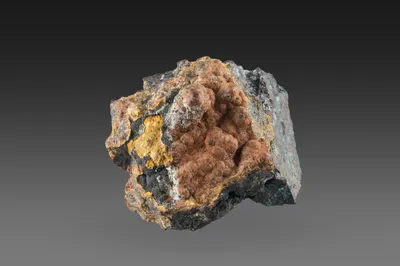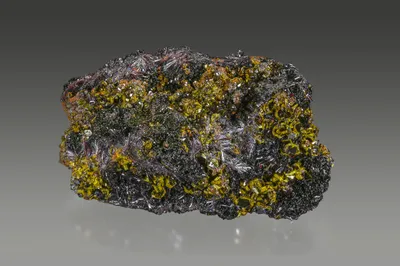
Image Credit: John Schneider
Mineral Species
Carminite
Type Locality
No
Composition
PbFe3+2(AsO4)2(OH)2
Crystal System
Orthorhombic
Status at Tsumeb
Confirmed
Abundance
Very rare
Distribution
Second oxidation zone
Paragenesis
Supergene
Entry Number
Species; TSNB69
General Notes
Acicular translucent crystals and radial aggregates with crystals of carminite to 10 mm were found in the second oxidation zone and are regarded as best of species (Von Bezing et al. 2007). According to Geier et al. (1971) carminite was first found at Tsumeb in 1964 on 30 Level, with beudantite, anglesite, mimetite and tsumcorite.
There is no confirmed report of carminite from either the first or third oxidation zone.
Strunz and Tennyson (1967) provided the earliest formal report of carminite from Tsumeb with crystallographic measurements. They noted that carminite is "always" associated with beudantite; typically, carminite presents as radial crusts and rosettes and only rarely as free-standing individual crystals. Crystals are typically elongated on the c-axis and needle-like or blade-like, the latter flattened on (010).
Keller (1984) described the crystals as prismatic to lath-shaped, with the colour ranging from light to deep-red.
Pinch and Wilson (1977) considered Tsumeb carminite to be "… the finest in the world". They described three associations:
- Most commonly with beudantite and arseniosiderite.
- With tsumcorite.
- With scorodite and anglesite.
Keller (1977a) placed carminite in one of his "Type II" parageneses (i.e., sequences forming under low pH conditions):
II/1: primary sulphides >> beudantite >> carminite >> anglesite >> mineral TK [= gartrellite]
A specimen in the Harvard University Collection (MGMH 11087) is particularly notable; measuring 13 cm across, it consists very substantially of acicular carminite crystals (to c. 10 mm) intergrown as crusts and radial aggregates, with tan coloured, tabular beudantite crystals also in abundance.
Carminite does occur without beudantite, albeit rarely. A specimen in the Southwood Collection (MS 2018.031; originally in the collection of Walter Kahn) comprises an open vug in massive sulphide lined with crystals of quartz and baryte (both presumably of hypogene origin) and richly encrusted with later spindle-shaped crystals of carminite; no other base metal secondary minerals are present.
Associated Minerals
anglesite; arseniosiderite; baryte; beaverite-(Cu); beudantite; chenevixite; corkite; ferrilotharmeyerite; gartrellite; pharmacosiderite; philipsbornite; quartz; scorodite; tsumcorite




